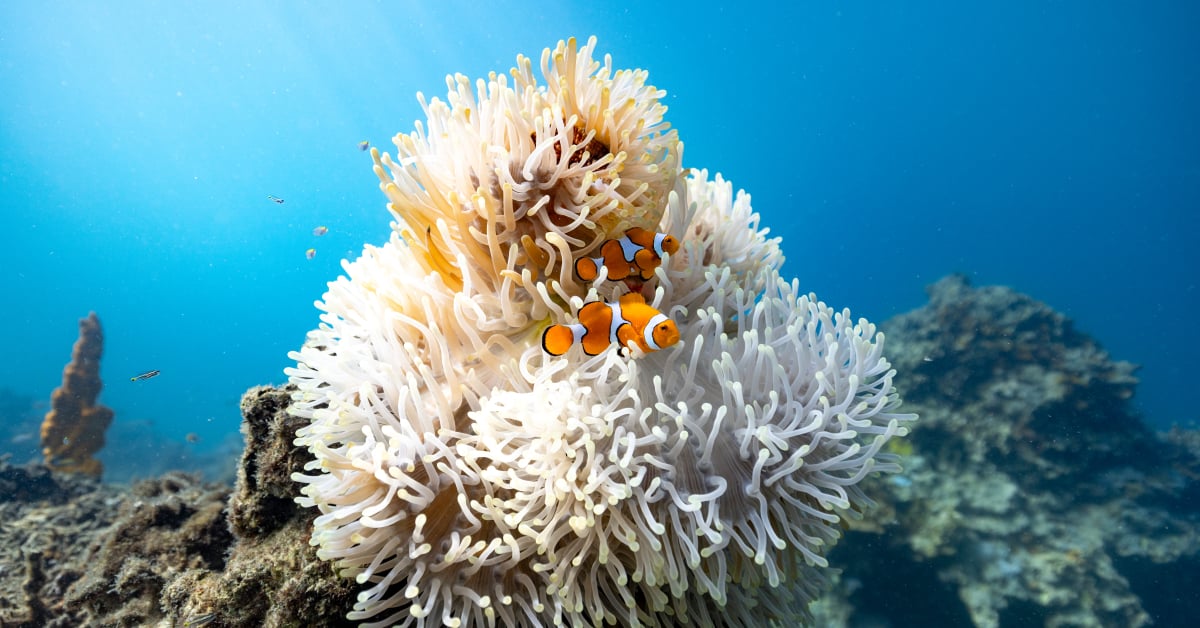Shrinking Nemo – the unusual way clownfish adapt to survive
2 July 2025 | By: Newcastle University | 3 min read
Animals are the masters of adaptation within rapidly changing environments, especially when faced with the risks of climate change.
Some are known to shift to lighter colourations to absorb less heat, while others expand the size of their beaks or feet to cool down faster. However, scientists Melissa Versteeg and Dr Theresa Rueger from our School of Natural and Environmental Sciences have observed a fascinating way that coral reef clownfish have adapted to survive heat stress while avoiding social conflict – they shrink.
Read on to find out why changing their size could help these iconic fish adapt to a warming ocean.
Contents:
Animal adaptation
Clownfish are a common fixture in marine and home aquariums and are widely known as the featured creature in Pixar’s 2003 film, ‘Finding Nemo’. But they are far from the first to undergo significant physiological transformation in response to stress or environmental changes. Species across the planet are finding novel ways to adapt to climate change. For example:
- Dragonflies with dark ornamental colouration are evolving with lighter appearances to lessen heat absorption and combat thermal stress
- Marine iguanas shrink and grow their body length by as much as 20% according to food availability and temperature changes, since their food of choice (red and green algae) can be affected by rising ocean temperatures
- Gang-gang cockatoos and red-rumped parrots in Australia have grown their beak sizes by between 4% and 10% since 1871
- The hindfoot size of African ground squirrels has increased to allow for a larger surface area, which helps them cool down faster in hot climates
Shrinking and shape-shifting
In collaboration with Mahonia Na Dari Conservation and Research Centre, in Kimbe Bay, Papua New Guinea, academics from the universities of Newcastle, Leeds (UK), and Boston (USA) measured a total of 134 clownfish during the course of the study. The team recorded the length of the clownfish every month for five months and monitored the water temperature every four to six days during a marine heatwave. They also examined breeding pairs of fish to determine whether changes in size would lead to social conflict, which can be another cause of mortality.
Out of the 134 clownfish studied, 100 were found to have shrunk in size at least once during the course of the study. Their findings – published in the journal Science Advances – record the first time that a coral reef fish has ‘shape-shifted’ to reduce the length of their body in response to environmental and social conditions.
‘Individual fish can shrink in response to heat stress, which is further impacted by social conflict, and that shrinking can lead to improving their chances of survival.’ Dr Theresa Rueger, Senior Lecturer in Tropical Marine Sciences
PhD researcher and study lead Melissa Versteeg says: ‘To be sure, we measured each fish individual repeatedly over a period of five months. In the end, we discovered shrinking was very common in this population. It was a surprise to see how rapidly clownfish can adapt to a changing environment and we witnessed how flexibly they regulated their size – as individuals and as breeding pairs – in response to heat stress as a successful technique to help them survive.’



The benefits of changing size
This is not just about getting skinnier under stressful conditions: these fish are getting shorter.
The team concluded that a single shrinking event increased an individual clownfish’s chance of surviving a heat stress event by 78% compared to individuals that did not shrink, and all clownfish that shrank multiple times survived to the end of the study period.
In addition, when both partners within a breeding pair shrank (referred to as paired shrinking), the probability of survival was higher than when only one or neither of the pair shrank. This indicates that both individual shrinking and shrinking in a coordinated fashion during a heat stress event can enhance the clownfish’s survival odds.
If individual shrinking were widespread and happening among different species of fish, it could provide a plausible alternative hypothesis for why the size many fish species is declining and further studies are needed in this area.
You might also like:
- read the study: Melissa A. Versteeg et al., Individual clown anemonefish shrink to survive heat stress and social conflict. Sci. Adv.11,eadt7079(2025).DOI:10.1126/sciadv.adt7079
- learn more about the researchers involved in this study:
- Dr Melissa Versteeg, PhD researcher and study lead
- Dr Theresa Rueger, Senior Lecturer in Tropical Marine Sciences and senior author of the study
- Dr Chancey Macdonald, NERC Independent Research Fellow in Coral Reef Ecology
- read the related articles:
- Newcastle University press release: ‘Shrinking Nemo: Clownfish survive heatwaves by shrinking’
- The Conversation: ‘Clownfish shrink during marine heatwaves – new study’
- BBC News: ‘Shrinking Nemo: Smaller clownfish sound alarm on ocean heat’
- discover more about the research of our School of Natural and Environmental Sciences
- explore how we are working towards protecting our planet for the benefit of all
Header image credit: Morgan Bennett-Smith
